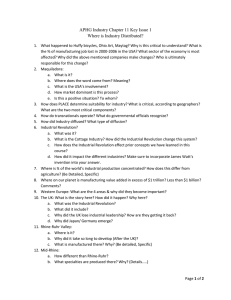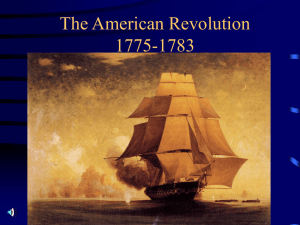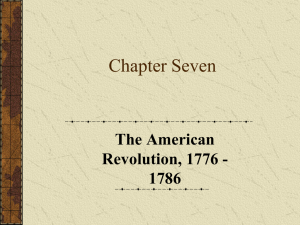Chapter Seven The American Revolution, 1776 - 1786
advertisement
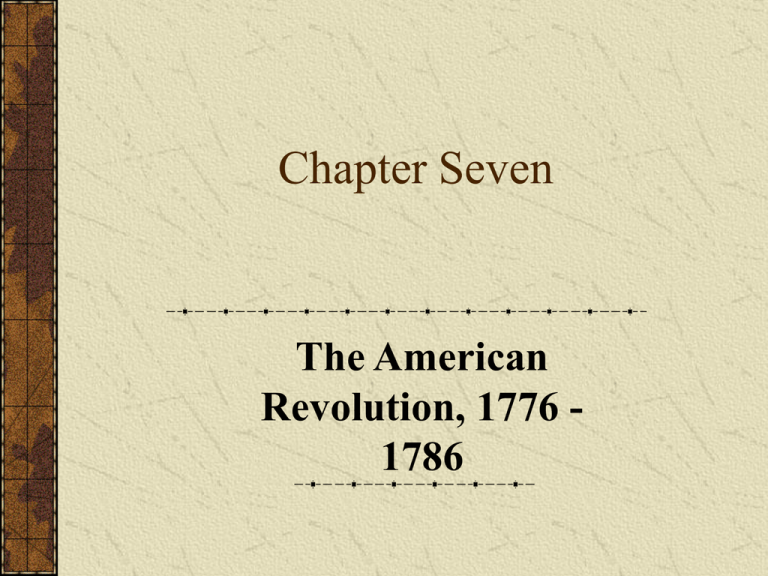
Chapter Seven The American Revolution, 1776 1786 Part One Introduction Chapter Focus Questions What were the major alignments and divisions among Americans during the American Revolution? What were the major military campaigns of the Revolution? What were the Articles of Confederation and what role did the Confederation Congress play during the Revolutionary War? How did the states serve as the setting for significant political change? What was the economic crisis in the aftermath of the American Revolution? Part Two A National Community Evolves at Valley Forge Building a Community at Valley Forge Drawn from all parts of the country, approximately 11,000 men (including 1,000 African Americans) and 700 women gathered in Valley Forge. Amid the suffering, the men and women at Valley Forge created a a common identity and strong bonds among themselves. Leaving Valley Forge six months later, Washington commanded a much stronger and united army. Part Three The War for Independence The Nature of American Resistance The British falsely assumed the colonial rebellion was the work of a small group of disgruntled conspirators. Resistance was widespread and geography stymied British strategy. The Patriot Forces American victory required a disciplined force able to stand up to the brutal assaults of the professionally-trained British adversaries. Regiments of the Continental Army suffered casualty rates as high as 40 percent. Both Continentals and militias played political roles, pressuring Congress when shortages of food and pay erupted. The Role of Women in the Revolution Women remained at home and ran the family farms and businesses. Many women joined their men in the military camps. On rare occasions, women played roles on the battlefields. The Loyalists About one-fifth of the colonial population remained loyal to the Crown, including African Americans, Indians, ethnic minorities, tenant farmers, British colonial officials, and Anglican clergy. Patriots cracked down on Loyalists. As many as 50,000 fought for the king and 80,000 fled the country after the Revolution. The most infamous British supporter was Benedict Arnold. The Campaign for New York and New Jersey Map: Campaign for New York and New Jersey, 1775 1777 The British plan was to cut off New England from the rest of the colonies by: Marching north from New York; and Marching south from Canada. The British drove Washington out of New York City and pursued him into New Jersey. After Washington’s Christmas Eve victory at Trenton, he adopted a defensive strategy of avoiding confrontation to insure survival of the Continental Army. The Northern Campaigns of 1777 Map: Northern Campaigns, 1777 - 1778 In 1777, the British tried to achieve the goal of cutting new England off from the rest of the colonies. General Burgoyne's large army was surrounded at Saratoga and surrendered. American forces in Pennsylvania were forced to retreat into Valley Forge. By the end of 1778, the war remained a stalemate. The French Alliance and the Spanish Borderlands During the first two years of conflict, French and Spanish loans helped finance the American cause. The victory at Saratoga led to an alliance with France. One year later, Spain joined the war, though without a formal American alliance. Both France and Spain worried about American expansion. The French entry into the conflict forced the British to withdraw troops from the mainland to protect their Caribbean colonies. The war at sea was mainly fought between British and French vessels, but Continental ships raided the British merchant shipping. Indian Peoples and the Revolution Although many Indians preferred a policy of neutrality, their fears of American expansion led many to side with Britain including: The Iroquois except for the Oneidas and Tuscaroras The Ohio Indians The Revolution in the West Map: Fighting in the West, 1778-1779 In the West, Ohio Indians allied with the British and attacked American settlements. George Rogers Clark countered by capturing several British posts. The War in the South Maps: Fighting in the South By the late 1770s, the British had shifted their focus to the South. Capturing Charleston in 1780, the British attempted to gain control over the rural south by implementing a policy of pacification that failed. Violence between Loyalists and Patriots created unrest. General Greene harassed British forces and they had to march to Yorktown where they were trapped by Washington's army; the British Army surrendered. Part Four The United States in Congress Assembled The Articles of Confederation Map: State Claims to Western Lands The Articles of Confederation was the first constitution of the United States. It created a loose union of autonomous states. Congress had limited central power, reserving powers such as taxation to the states. Maryland held up ratification for three years until the eight states with western land claims ceded them to the national government. Financing the War Though benefiting from foreign subsidies, Congress and the states financed the revolution mainly by issuing paper currency that caused runaway inflation. Secretary of Finance, Robert Morris, met interest payments on the debt, but did not persuade Congress to come up with an independent source of income. Chart: Postwar Inflation Negotiating Independence Peace negotiations began in 1782 and resulted in a series of separate treaties between Great Britain and the United States, France, and Spain. The United States gained: independence; the promise of the withdrawal of British troops, land to the Mississippi River; and fishing rights. North America after the Treaty of Paris Map: North America after the Treaty of Paris, 1783 The Crisis of Demobilization Congress had neither paid the soldiers nor delivered the officers their promised postwar bounties or land warrants. Several officers stationed at Newburgh contemplated action if Congress failed to act, but they were shamed into accepting civilian rule by George Washington. The Problem of the West Western land settlement raised new issues, including: land losses for several Indian tribes. tens of thousands of Americans rushing into the newly acquired Ohio River Valley. British and Spanish governments plotting to woo the settlers. The Land Ordinance of 1785 Map: The Land Ordinance of 1785 Three land ordinances provided for organizing the land for settlement, selfgovernment and eventual statehood. They also provided for orderly division of land into townships, regular land sales, and the abolition of slavery in the Northwest Territory. Part Five Revolutionary Politics in the States The Broadened Base of Politics Most states had greatly expanded the electorate. By eliminating Tories from politics, there was a shift to the left. Many Americans accepted a new democratic ideology that asserted that governments should directly reflect popular wishes. Conservatives argued for balanced government, fearing majority tyranny could lead to a violation of property rights. The First State Constitutions Fourteen states adopted constitutions between 1776 and 1780. The new state constitutions were shaped by the debates between radicals and conservatives. Democrats had seized power in Pennsylvania in 1776 and drafted a constitution that placed all power in a unicameral assembly elected by all free male taxpayers. Conservatives controlled Maryland who maintained high property requirements for office-holding. Other states drafted constitutions between these extremes. Declaration of Rights Virginia’s Declaration of Rights provided the model for other state guarantees of such rights as freedom of speech, assembly, and the press. State bills of rights were important precedents of the United States Bill of Rights. The 1776 New Jersey constitution enfranchised women, but most questions regarding women were related to the family. Led by Thomas Jefferson, states abolished aristocratic inheritance customs and established religious freedom. African Americans and the Revolution More than 50,000 slaves were taken away from the South by the British. Thousands of others fought for the Patriots and won their freedom. Recognizing the contradiction between a revolution for liberty and the continued support for slavery: northern states began to abolish slavery; and the Upper South relaxed its bans on emancipation. A free African American community emerged with racially defined churches, schools and other institutions. Several African American writers became prominent. Part Six Conclusion The Creation of the United States 1776– 1786 Media: Chronology

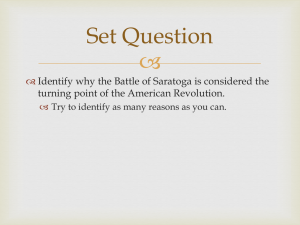
![American_Revolution[1][1]](http://s2.studylib.net/store/data/009960254_1-4da48c1e20c010b1d15112f43dbd0302-300x300.png)


